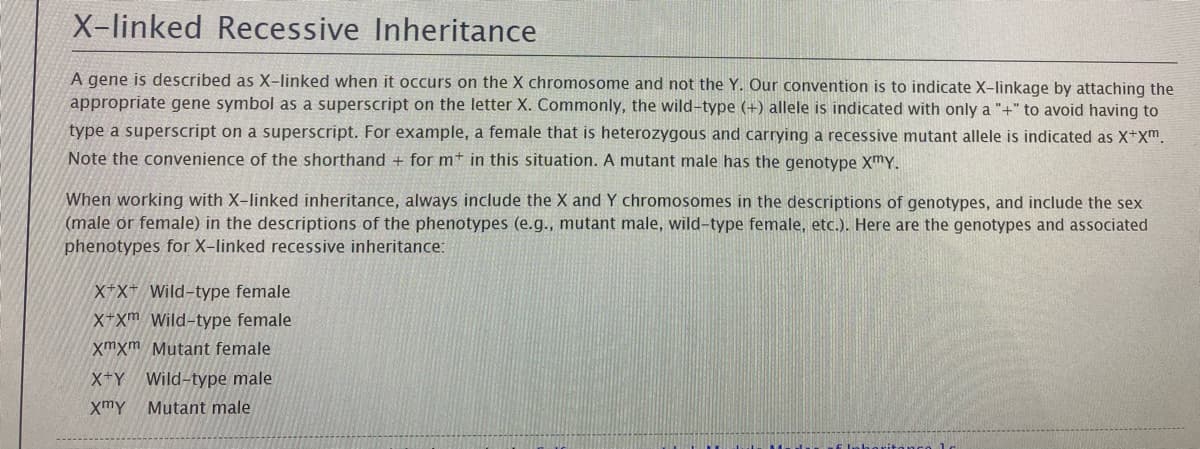A gene is described as X-linked when it occurs on the X chromosome and not the Y. Our convention is to indicate X-linkage by attaching the appropriate gene symbol as a superscript on the letter X. Commonly, the wild-type (+) allele is indicated with only a "+" to avoid having to type a superscript on a superscript. For example, a female that is heterozygous and carrying a recessive mutant allele is indicated as X+Xm. Note the convenience of the shorthand + for m+ in this situation. A mutant male has the genotype XmY. When working with X-linked inheritance, always include the X and Y chromosomes in the descriptions of genotypes, and include the sex (male or female) in the descriptions of the phenotypes (e.g., mutant male, wild-type female, etc.). Here are the genotypes and associated phenotypes for X-linked recessive inheritance: X+X+ Wild-type female X+Xm Wild-type female xmxm Mutant female X+Y Wild-type male xmy Mutant male
A gene is described as X-linked when it occurs on the X chromosome and not the Y. Our convention is to indicate X-linkage by attaching the appropriate gene symbol as a superscript on the letter X. Commonly, the wild-type (+) allele is indicated with only a "+" to avoid having to type a superscript on a superscript. For example, a female that is heterozygous and carrying a recessive mutant allele is indicated as X+Xm. Note the convenience of the shorthand + for m+ in this situation. A mutant male has the genotype XmY. When working with X-linked inheritance, always include the X and Y chromosomes in the descriptions of genotypes, and include the sex (male or female) in the descriptions of the phenotypes (e.g., mutant male, wild-type female, etc.). Here are the genotypes and associated phenotypes for X-linked recessive inheritance: X+X+ Wild-type female X+Xm Wild-type female xmxm Mutant female X+Y Wild-type male xmy Mutant male
Human Heredity: Principles and Issues (MindTap Course List)
11th Edition
ISBN:9781305251052
Author:Michael Cummings
Publisher:Michael Cummings
Chapter4: Pedigree Analysis In Human Genetics
Section: Chapter Questions
Problem 19QP: Analysis of X-Linked Dominant and Recessive Traits Suppose a couple, both phenotypically normal,...
Related questions
Topic Video
Question

Transcribed Image Text:X-linked Recessive Inheritance
A gene is described as X-linked when it occurs on the X chromosome and not the Y. Our convention is to indicate X-linkage by attaching the
appropriate gene symbol as a superscript on the letter X. Commonly, the wild-type (+) allele is indicated with only a "+" to avoid having to
type a superscript on a superscript. For example, a female that is heterozygous and carrying a recessive mutant allele is indicated as X+Xm.
Note the convenience of the shorthand + for m+ in this situation. A mutant male has the genotype XmY.
When working with X-linked inheritance, always include the X and Y chromosomes in the descriptions of genotypes, and include the sex
(male or female) in the descriptions of the phenotypes (e.g., mutant male, wild-type female, etc.). Here are the genotypes and associated
phenotypes for X-linked recessive inheritance:
X+X+ Wild-type female
X+Xm Wild-type female
xmxm Mutant female
X+Y
xmy
Wild-type male
Mutant male
Expert Solution
This question has been solved!
Explore an expertly crafted, step-by-step solution for a thorough understanding of key concepts.
Step by step
Solved in 2 steps

Knowledge Booster
Learn more about
Need a deep-dive on the concept behind this application? Look no further. Learn more about this topic, biology and related others by exploring similar questions and additional content below.Recommended textbooks for you

Human Heredity: Principles and Issues (MindTap Co…
Biology
ISBN:
9781305251052
Author:
Michael Cummings
Publisher:
Cengage Learning

Human Heredity: Principles and Issues (MindTap Co…
Biology
ISBN:
9781305251052
Author:
Michael Cummings
Publisher:
Cengage Learning